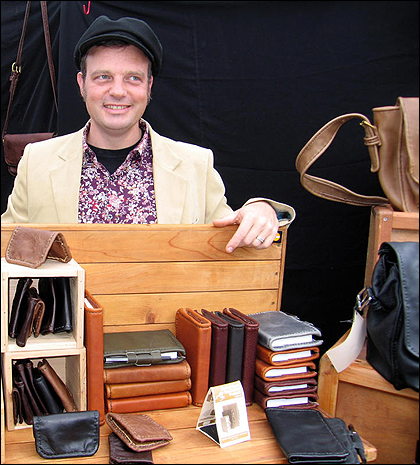2011 Oregon Country Fair
Kickin Out the Jams Warpaint, Marv Ellis bring it all back homeû
Green Team OCF strives for sustainability
Blooming Artists OCF Youth Booth craft guild nurtures artistic expressionû
Craft of the Stone Age Leatherworkers maintain small, steady presence at the Fair
Craft of the Stone Age
Leatherworkers maintain small, steady presence at the Fair
By Brit McGinnis
øIts like Indiana Jones central,” artisan Dan Groussman says of the decidedly unfussy leather satchels he makes. Indeed, many of his Hippo Handcrafted Products wouldnt look out of place hanging off an explorers shoulder. øWhen (these people) walk in, I actually say, *Youre my ideal customer,” Groussman says.
 |
| Dan Groussman |
 |
The Oregon Country Fair hosts a wide variety of craft booths every year, though only 10 stalls selling leather goods will be featured this time around. But with Oregons cowboy culture, demand for leather goods never seems to be an issue. From belts to parfleches (a type of Native American rawhide bag), theres plenty to satisfy anyones rawhide madness.
Hippo Handcrafted Products, however, is one company that takes the ancient craft to a whole new level. The goods are designed for practicality, with no rhinestones or glitter buckles. The online store has a range of products, from small bi-fold wallets ($52) up to the mack-daddy Saranella satchel. Big enough to hold a laptop and a load of magazines, it costs a cool $1,060.û
The price can be partly explained by Groussmans attention to detail. øRegardless of cost, you have to have the best quality,” he says. He talks about his material with a great fondness. Classic rawhide can be brittle, Groussman explains. Hed rather work with øthe kind youd want to squish your face against.” Suddenly, paying more than $100 for a planner makes sense.
On a certain level, its surprising that leatherworking has survived so long as part of Oregons craft heritage. Leather has garnered a stigma over the years because of its animal source ‹ not to mention that modern tanning often involves smearing the skin with plant or chemical derivatives. At times, the leather may even be preserved with oil made from mink fat or cattle bones.
But Groussman doesnt seem that bothered. øA lot of these processes are those weve been using since the dawn of time,” he says. øIt was probably our first craft.” Groussman expresses empathy with people thinking about animal rights. But as a crafter, he has no qualms about working with his leather material of choice, cowhide. øThe difference between skin and leather is like the difference between a tree and paper,” he says.
Many people actually bring up ethics issues whenever he runs his craft booth, Groussman says. After more than 15 years working at the Fremont Sunday Market in Seattle, he says he cant recall any incidents that turned ugly. øI usually just engage them in a conversation.”
Groussman says he believes in the integrity of his product, so much that it occasionally hinders innovation. For example, the idea of combining the hides of two different animals made him uncomfortable for years. øI didnt want to combine the genetic material,” he says. But his attitude changed over time, and he now mixes the colors to make øbi-cow” and øtri-cow” pieces.
Groussman is prepared to jump in to the fray of leatherworkers at the Oregon Country Fair. The OCF features artisans who also dabble in bone, full hides and taxidermy. In Groussmans experience, the demand for leather has not gone down significantly, only changed. He receives ideas for new products all the time. The latest? An all-leather iPod sleeve: the ultimate crossover between cowboy and city slicker.û